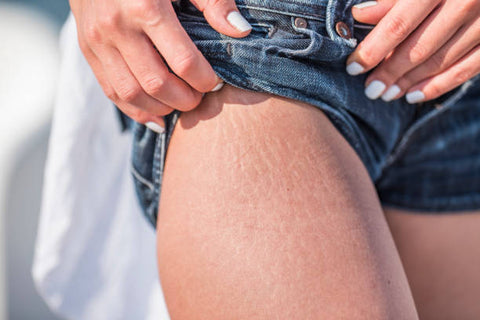Stretch marks, medically known as striae distensae, are a common dermatological concern affecting individuals of all ages and genders. These visible streaks or lines on the skin often occur due to rapid stretching or shrinking of the skin's dermal layer, resulting in a characteristic appearance that can impact self-esteem and confidence.

Causes of Stretch Marks
1. Rapid Weight Changes: Significant weight gain or loss, particularly during pregnancy, puberty, or rapid muscle growth from bodybuilding, can lead to the formation of stretch marks as the skin stretches beyond its elastic limit.
2. Genetic Predisposition: Genetic factors play a role in determining an individual's susceptibility to stretch marks. Those with a family history of stretch marks may be more prone to developing them under similar circumstances.
3. Hormonal Changes: Hormonal fluctuations, such as those occurring during puberty, pregnancy, or hormonal therapy, can affect the skin's elasticity and increase the likelihood of stretch mark formation.
Exploring Treatment Options for Stretch Marks
1. Topical Treatments: Various topical creams, lotions, and oils containing ingredients such as retinoids, hyaluronic acid, vitamin E, and collagen-boosting peptides may help improve the appearance of stretch marks by promoting skin regeneration and elasticity.
2. Cosmetic Procedures: Dermatological procedures such as laser therapy, microdermabrasion, microneedling, and chemical peels can be effective in reducing the visibility of stretch marks by stimulating collagen production and remodeling the skin's surface.
3. Home Remedies: Natural remedies like aloe vera gel, coconut oil, almond oil, and shea butter may provide moisturization and nourishment to the skin, potentially diminishing the appearance of stretch marks over time.
Preventive Measures to Minimize Stretch Mark Formation
1. Hydration and Nutrition: Maintaining a well-balanced diet rich in vitamins, minerals, and essential fatty acids, along with staying hydrated by drinking plenty of water, can support skin health and elasticity, reducing the risk of stretch marks.
2. Gradual Weight Management: Gradual and steady weight loss or gain, achieved through healthy lifestyle choices and regular exercise, can help minimize the strain on the skin and prevent the rapid stretching that contributes to stretch mark formation.
3. Skin Care Practices: Regularly moisturizing the skin with hydrating lotions or oils, especially in areas prone to stretch marks such as the abdomen, thighs, hips, and breasts, can improve skin elasticity and resilience.
Conclusion: Embracing Skin Resilience and Confidence
While stretch marks may be a common occurrence, they need not detract from one's sense of confidence and well-being. By understanding the underlying causes, exploring treatment options, and adopting preventive measures, individuals can take proactive steps to manage stretch marks effectively and embrace their skin's natural resilience and beauty.
Author: Nikita Vishnoi BCA












